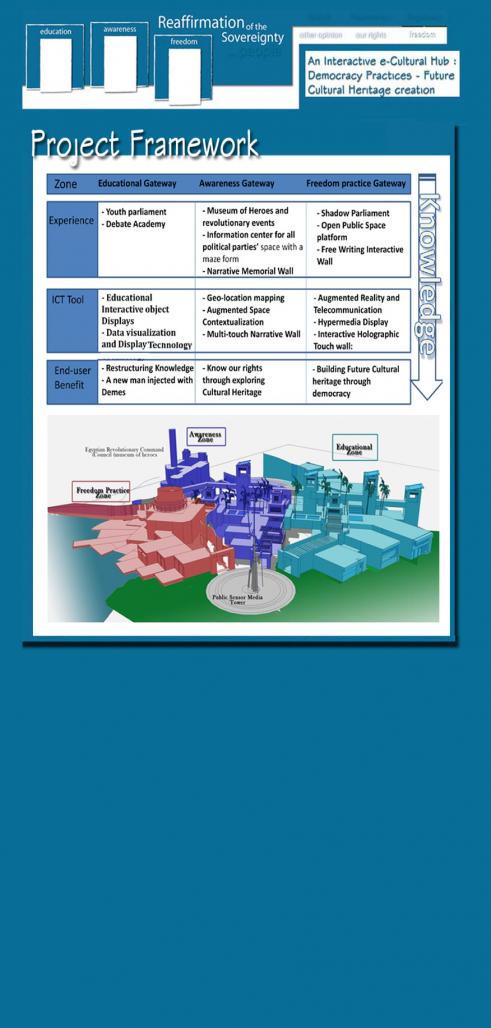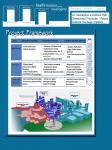An Interactive e-Cultural Hub for: Democracy practice - Future Cultural Heritage Creation
An Interactive e-Cultural Hub is interceding between Informal public space (Square) and formal one (parliament). The target is to allow these public claims to turn into actions. Responding to the unexpected worldwide phenomena of political refusal status which reflected as Cultural Revolutions. These revolutions created work of art that should be documented as future cultural heritage. This time a memorial shouldn’t be only for a hero but also for the whole society that should be commemorated and disseminate with their outstanding cultural events like the Egyptian revolution 25 February 2011 with all its notable impact to generate active cultural heritage experience and for sustaining Social communication that generates those revolution actions by giving the power to take back control.
This concept was elaborated by improving the use of cultural resources through creative experiences and creating a new access of knowledge. awareness of our rights and learning ethics of debate from heritage as practice of democracy from the time of Athens Agora till we reach liberation square in instant timeline, protesting and freedom of speech , exploring the previous experience, valorizing cultural political events, monitoring the government, restructuring of our society, decreasing the gap between public and government by creating one platform for public communication practice, monitoring their opinions and creating future cultural heritage.
The goal Achievement is through creating diverse architectural zones that Exploit ICT to Design fractals of cultural heritage experiences. It places cultural heritage in the context of democracy creation. ICT created a space for practicing democracy and a new function for cultural heritage as a tool for political awareness and education. An Instant documentation for all valuable events that sustain future culture heritage.
Hosting this new building typology, resurrects two vital historical spots Egyptian Revolutionary Command Council and the liberation Square (Tahrir square ) with their historical value and their notable hosted events. The potentials of liberation square , it was officially renamed since The Egyptian Revolution of 1919 and finally earned its name after 30years, after centuries of shifting roles and identities, liberation square has became a hub for freedom.
Egyptian Revolutionary Command Council (museum of heroes) is The place hosted all RCC Initial Membership. It witnessed a most eventful period in the Egyptian history during 1952 revolution Simulation of events. It’s vital location on the Nile bank and adjacent to Liberation Garden that was built 1876 that played a important role as public space in historical period
2009
2011
This project proposes ICT as a tool that bridges the gap between the social communication with its digital accesses and the physical cultural experience within public space. ICT is a field that can efficiently contribute with visual reality. It can provide visibility of a unique cultural heritage type that is resulted from these revolutions’ work of art.
The Required ICT Concepts and Tools:
1. Data visualization and Display Technology :
- Digitalization of intangible material for revolution as events and the context status, archive for the whole situation.
- Archives of pre-Existing historical events.
- Provides multimedia content like geographical data, photorealistic 3D models, videos and pictures of whole events.
2. Augmented Space Contextualization
In Museum of Heroes in Revolutionary Command Council building creating a museum by continuing the right exact context and event with integrating reality to virtual. This encourages the action of perception and discovering the historical events within its context
3. Educational Interactive Displays:
- This interactive space inside the debate academy and the youth academy include interactive floor projections, multi-user touch walls, interactive table projections to facilitate the action of learning and perceiving political and debate ethics and morals.
4. Sensor Media Tower:
- To measure the public satisfaction and mood.
- It converts the use of the platform with its floor sensor to a distinguishable color that acts as a landmark to the public space.
5. Multi-Touch Narrative Wall
- Representation of previous events. - Methods for synchronization of cultural heritage so to offer personalized exploitative and cognitive routes based on user profiles
6. Interactive Holographic Touch wall
- It displays screen with multi touch information wall to allow civil to express their opinion, network between the two interactive multimedia walls interconnecting the Tahrir square local representation to the Egyptian revolutionary command council local.








